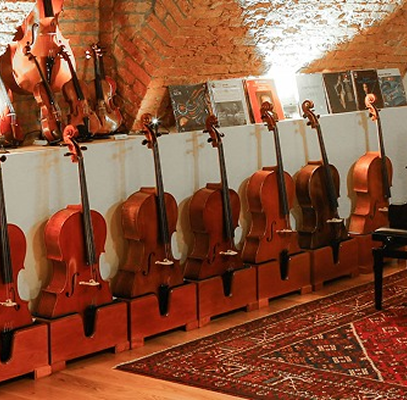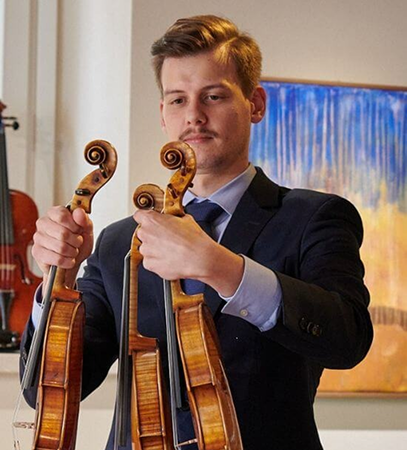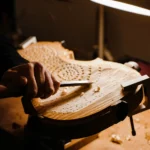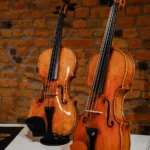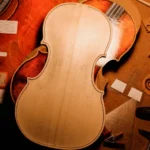The Best Violins for Professionals
Back to BlogThe Best Violins for Professionals — What to Look For in a High-End Instrument
Every professional violinist experiences a moment when the instrument comes alive, becoming part of their very essence. The best violins for the professionals is not just a finely crafted piece of wood, it’s a voice, shaped by the creativity, artistry, and handiwork of generations, designed to travel from private studios to concert halls. This guide will look at what truly makes these ultra-high-end instruments special.
What Defines the Best Violin for Professionals?
Tone, Projection, and Responsiveness
The best violins for professional use must be able to produce a clear voice that projects throughout the concert hall without stripping the palette of colors or warmth. It must have the ability to converse intimately with the player while remaining personally accessible.
Moreover, professional players want violins that will respond to instantaneous changes in bow and vibrato direction. Being responsive allows technical confidence and transformational artistry and unleashes expressive freedom that allows the player to sound large or small, depending on their musical wishes.
Dynamic Range for the Stage and Recording Studio
Dynamic flexibility is inherent to a professional violin, where the ability to go from whisper-soft pianissimos to powerful fortissimos is critical. On stage, a professional violinist is able to finesse their volume to cut across the orchestra as a soloist, then fit in seamlessly when appropriate.
In the recording studio, dynamic flexibility and sensitivity provide a way to guarantee every note can be clearly interpreted with respect to its associated nuance. A violin that can be tonally balanced across a range of extremes becomes a trusted partner, helping musicians adapt seamlessly between performance environments.
Craftsmanship, Tonewoods, and Build Quality
Spruce Tops and Maple Backs
At the heart of your violin is the wood that makes it. With clarity and stickiness, spruce has the resonance that will be heard from the front of the house. Maple on the back and ribs creates determination and brilliance. They need to fit together in a way that creates the best violin for professionals to play.
Finding the right balance of warmth and projection has been the goal in violin making for centuries. Contemporary luthiers make the most out of the traditions and process of hand-picking, taking extra time to select spruce and maple for stability and character, and quality that ages gracefully.
Arching, Graduation, and Handwork
Besides the materials, craftsmanship also contributes to defining the voice of the instrument. The arching allows the vibration to travel how it is supposed to, while the graduation, the careful thinning of the wood, gives shape to resonance and power. Every stroke of the gouge illustrates a maker’s artistry, turning raw wood into an instrument of music.
Moreover, contemporary luthiers such as Luiz Amorim’s meticulous handwork exemplifies this craft, blending precision with intuition. The result is a violin that persists even after decades of performance, carrying both the maker’s touch and the musician’s voice.
Setup and Playability — Comfort Matters Daily
Bridge, Soundpost, and Fingerboard Fit
A fine bridge and soundpost act as the pulse of the violin, encouraging vibrations produced by the strings to be transferred properly and shaping the tonal imbalance. The fingerboard must be properly shaped and positioned to allow smooth shifting and precise intonation.
If these three setups aren’t just right, even the best violin can seem unresponsive, draining to play, and stripped of the joy it’s meant to bring. Proper setup allows you to perform on your instrument, which transforms difficult passages into an expression of art that requires little effort.
String Choices and Adjustability
String choices represent the intersection of a violin and the player’s touch. Small differences in strings can have a drastic effect on an instrument’s personality. Professional players will often play with many different types of strings to find what best matches their needs for brightness, warmth, and projection.
Adjustable fittings, such as tailpieces and fine tuners, can also facilitate flexibility in the user experiencing the instrument as the player wishes. When a violin is set up for flexibility, a player will feel empowered to adapt to a contextual situation quickly, either when playing as an advanced player in an ensemble or as a soloist.
Modern Instruments Versus Old Italians
Blind Tests and Unexpected Outcomes
Blind tests and blind listening studies have repeatedly confirmed that contemporary violins can at least match the projection and player preference of antiques, and in some cases, have surpassed them. The best violins for professionals are no longer defined by centuries of age, as modern makers have achieved exceptional tone, playability, and reliability. In other words, the art form is advancing beyond that of past Italian traditions.
What Legendary Antiques Do Still Deliver
On the other hand, contemporary instruments can certainly be advanced, but the timeless cultural and historical values of old Italian violins by people like Stradivari or Guarneri cannot be replaced.
They provide the known durability of a classic antique, often viewed as an alternative investment, and their prominent innate tonal character. This generally allows them to be preferred over newer instruments, which inherently makes them valuable to both collectors and performers. They provide a legacy that takes today’s musicians back through time while connecting them to centuries of artistry and timeless musical heritage.
Bows and Strings — Completing Your Professional Setup
Bow Control and Articulation
A bow is more than a piece of equipment — it is half of the voice of the instrument. The right bow determines the articulation, clarity, and color of the instrument, allowing the musician to unlock the subtleties needed for great playing.
Whether spiccato with a crisp attack or sustained legato, the right bow can change the expression as a whole. Professional players will often try multiple bows to find one that best aligns with the character of their particular violin.
Matching Strings to Your Sound Goals
Strings are the perfect way to adjust a tone without replacing the instrument. Bright strings allow the instrument to project its voice like a singer in a stadium, and the warmer strings generate depth and richness. You can alter the tension and evaluate the sound of mixed-string brands to accommodate the acoustics of the hall and your repertoire choices. With some consideration, you can find strings that will turn your instrument into a remarkably versatile partner in all performance environments.
Provenance and Certification — Protecting Your Investment
Certificates and Recognized Experts
When buying fine violins, it’s important to recognize that authenticity is of utmost importance. Certificates from considered experts are valuable, providing musicians with a measure of assurance regarding origin, maker, and value. For collectors and performers, having proper documentation in place guarantees that they select the best violin for professionals, which retains its artistic quality and financial integrity for future generations.
Repair, condition, and resale value
The history of a violin is defined by the physical condition of the instrument. Transparent repair records will not only preserve tonal quality, but they will also preserve market value in case of resale or ownership transfer. For professionals, having repair records helps protect insurance, ease the resale of the instrument, and protect a large, calculated investment. Plus, detailed record keeping changes an instrument from a tool to a protected legacy.
How to Test the Best Violins for Professionals Before You Buy
- Hall Testing – Play in a large environment to see how sound travels. Listen for clarity, balance, and projection.
- Studio Testing – Record under microphones to evaluate for tonal detail, warmth, and responsiveness, prior to playing in a real concert situation.
- Test with Other Instruments – Play with other instruments to evaluate balance, tone, and blend.
- Endurance Testing – Perform extended passages to check for comfort, stability, and endurance over the length of the performances.
Sound, Craft, Legacy — Finding your Professional Violin
A professional violin is about sound, feel, and lineage of an instrument that includes artistry and lasting value. Interested in fine violins and violas, crafted by those who drew inspiration from legendary makers? Check out Amorim’s selection to find your most prized performance or professional violin.

